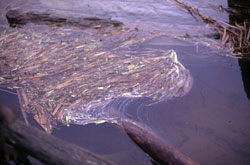Putting Pollution in Perspective
By Lisa Flinn, Crawford County Conservation District Intern
 Which is worse: chemical discharge from a pipe or pesticides from 50 suburban lawns running off into a creek? Actually, they rank at about the same level since they all can be potentially poisonous. But which would the public consider worse socially? Certainly, it is easiest to point a finger at a large industry discharging waste into a creek, but that is only because industrial discharge is a point source of pollution. Point source means that the pollution can be traced back to one source; it is identifiable. Non-point source pollution, on the other hand, cannot be traced to a specific location, such as a wastewater treatment plant and run-off. Non-point source refers to an area, since a source is unidentifiable.
Which is worse: chemical discharge from a pipe or pesticides from 50 suburban lawns running off into a creek? Actually, they rank at about the same level since they all can be potentially poisonous. But which would the public consider worse socially? Certainly, it is easiest to point a finger at a large industry discharging waste into a creek, but that is only because industrial discharge is a point source of pollution. Point source means that the pollution can be traced back to one source; it is identifiable. Non-point source pollution, on the other hand, cannot be traced to a specific location, such as a wastewater treatment plant and run-off. Non-point source refers to an area, since a source is unidentifiable.
Rural areas using fertilizers and pesticides, suburban areas using lawn and household chemicals, and urban areas with storm run-off are all non-point sources of pollution. The only difference between these two types of sources is that the point source can be simpler to correct, because its source is identifiable. The non-point source pollution can be just as harmful, but correcting the problem could be more complicated, since many people may be responsible. For instance, if a landowner over applies fertilizer to his land right before a vigorous rainstorm, the fertilizer will dissolve into the rainwater, flow to a lower elevation and eventually into a water source in the watershed. The extra nutrients from the fertilizer, mostly nitrogen and phosporus, can lead to chemical imbalances in the waterway. The imbalances can put stress on aquatic life, and prime the waterway for eutrophication. Eutrophication is a process where too many nutrients enter the waterway.
The waterway may become green, malodorous, oxygen deficient and have extensive algae growth. In this way, a landowner thirty miles downstream from the first landowner has to battle eutrophication in his waterway. Pin-pointing the fertilizer pollution would be nearly impossible after blending with the stream for thirty miles. But, if the run-off continued to go unchecked, we would see the fruit of the irresponsibility we planted: decline in fishing and other recreational uses, decline in species or lack of biodiversity, and possibly even a decline in public health. Pesticides, livestock manure, sedimentation, lawn chemicals, storm run-off, and run-off from paved surfaces all interfere with the proper chemistry and aesthetics of a watershed.
It is important to realize the difference between point source pollution and non-point source pollution so that our waterways stay healthy. Plus, if a problem did happen to occur we would know the best way to correct it. The good news is that people have already begun identifying sources of possible pollution and are working to help find more “eco-friendly” alternatives to pollution. Over 60 Junior High and Senior High school classes in western Pennsylvania regularly “test” their local streams through Creek Connections, located in Allegheny College. By recording the different chemical parameters of their stream, the students can analyze the health of their waterway throughout the school year and watch for possible sources of pollution. Senior Citizens are also putting on their hipwaders and chemically testing French Creek through the Environmental Alliance for Senior Involvement (EASI) affiliated with The French Creek Project. They collect macroinvertebrates, or bugs, twice a year to analyze the water quality, since certain bugs, like the Mayfly, can only live in unpolluted waters. Further, local farmers have been installing milkhouse waste treatment systems to limit the amount of milkhouse waste entering a creek. Because the wastewater is treated and redirected, the land generally becomes more stable for livestock and more profitable for the farmer, since upkeep costs are diminished.

